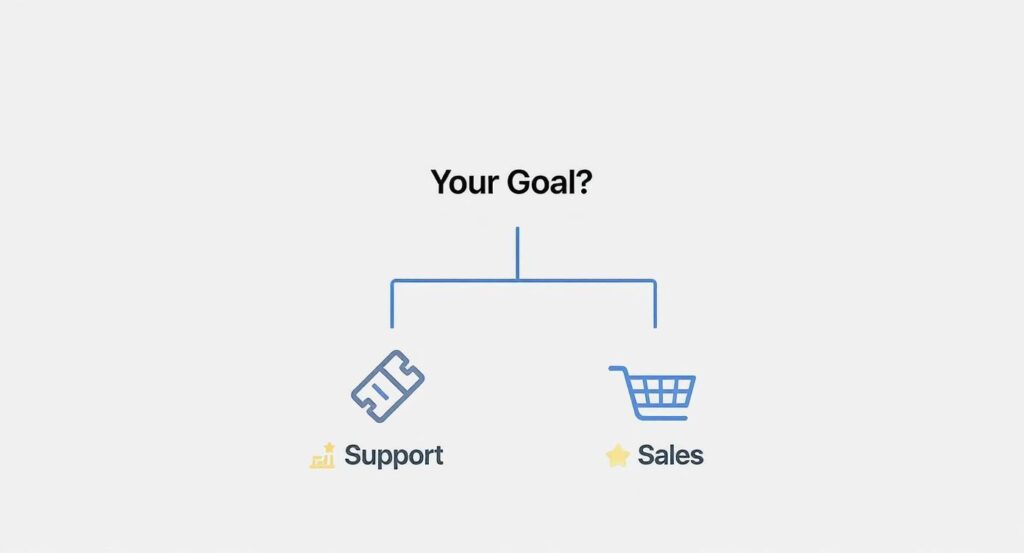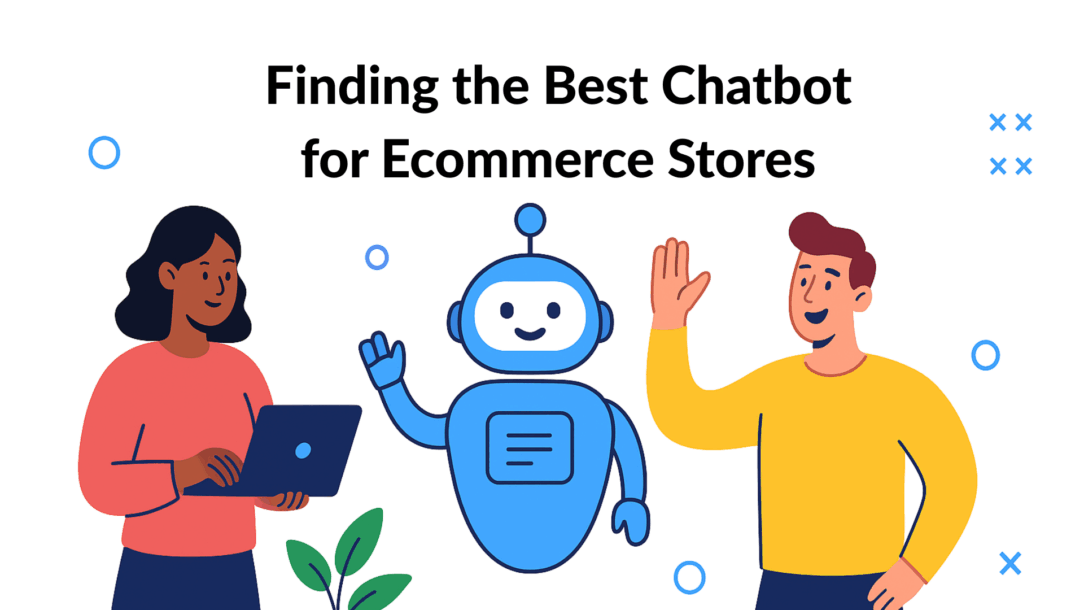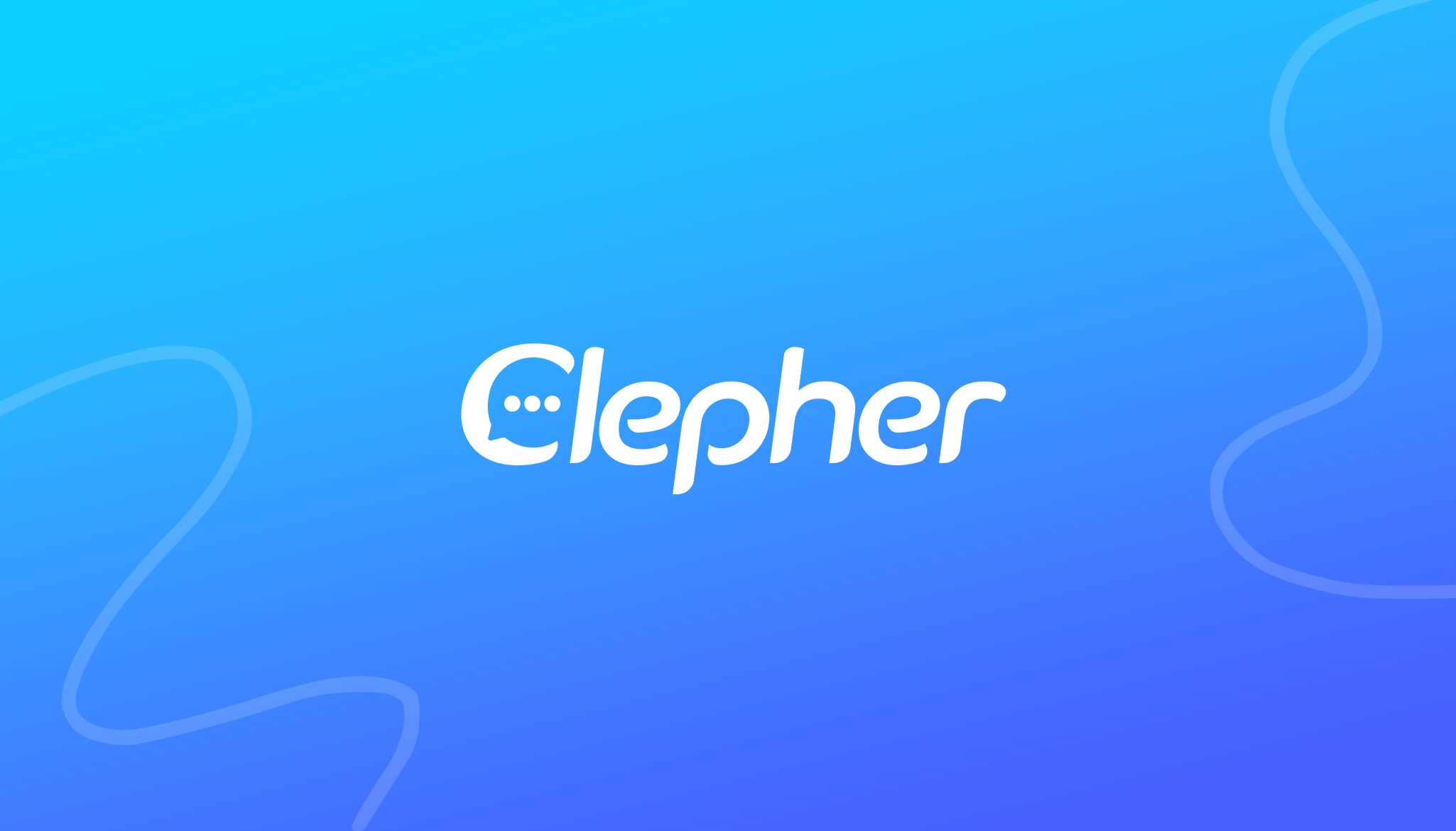Think of the best chatbot for ecommerce not as a tool, but as your store’s most valuable employee. It’s your 24/7 sales associate who never calls in sick, working around the clock to turn casual browsers into loyal customers. The right chatbot doesn’t just answer questions; it actively recovers abandoned carts, offers smart product recommendations, and solves problems instantly, directly boosting your bottom line.
Why Your Ecommerce Store Needs a Chatbot Now

ecommerce chatbots
It’s 11 PM on a Tuesday. A potential customer is ready to buy but has one last-minute question about sizing. Your support team is offline. Without an instant answer, that sale is gone—probably forever. This is the exact scenario where a great ecommerce chatbot completely changes the game.
Forget the clunky, robotic chat windows of the past. Today’s chatbots for ecommerce are a core part of a winning online sales strategy. They’ve evolved from simple FAQ bots into proactive digital assistants that guide shoppers through their entire buying journey and resolve issues on the spot.
The Real-World Impact on Your Bottom Line
Imagine a customer struggling to apply a discount code at checkout. Frustration is setting in, and they’re about to click away. Just then, your chatbot pops up, identifies the problem, and helps them complete the purchase. That’s not a futuristic concept—it’s a high-impact use case that directly recovers otherwise lost revenue.
This is why the best ecommerce chatbots are becoming indispensable for modern online stores. They not only answer questions but also recommend products, recover abandoned carts, and even upsell relevant items—all automatically.
Let’s look at some common ecommerce headaches and see how a chatbot offers a direct solution.
Key Ecommerce Problems Solved by Chatbots
| Common Ecommerce Problem | How a Chatbot Solves It | Potential Business Impact |
|---|---|---|
| High Cart Abandonment Rates | Proactively engages users at checkout with help or incentives. | Recovers lost sales, increases conversion rates. |
| 24/7 Support Is Expensive | Provides instant, automated answers to common questions around the clock. | Reduces support costs, improves customer satisfaction. |
| Generic Shopping Experience | Offers personalized product recommendations based on user behavior. | Increases average order value (AOV) and engagement. |
| Repetitive Support Queries | Automates responses to “Where is my order?” and other FAQs. | Frees up human agents for high-value, complex issues. |
As you can see, a well-implemented chatbot isn’t just a “nice-to-have” feature; it’s a strategic asset that tackles some of the biggest challenges ecommerce stores face every day.
A chatbot isn’t just a support tool; it’s a revenue-generating machine. By automating common tasks and providing instant, personalized assistance, it directly contributes to higher conversion rates and increased customer lifetime value.
The magic behind a great ecommerce chatbot is conversational AI, the technology that allows bots to understand and respond to human language in a natural way. This intelligence is what enables the best chatbots to handle nuanced questions and guide customers effectively. You can learn more about how an AI chatbot for ecommerce can boost your conversion in our detailed guide.
The market numbers back this up. The global chatbot industry, valued at USD 7.76 billion, is expected to skyrocket to USD 27.29 billion by 2030. This explosive growth is fueled by AI advancements that are giving ecommerce businesses a serious competitive edge. It’s clear that adopting a chatbot is no longer optional—it’s essential for growth.
Figuring Out What ‘Best’ Actually Means for Your Business
Jumping into chatbot reviews without a clear goal is like grocery shopping without a list—you’ll end up with a cart full of things you don’t actually need. The “best” chatbot is subjective; the perfect tool for a small boutique selling handmade jewelry is wildly different from what a high-volume electronics retailer needs.
Before looking at any platform, you must define what success looks like for your store. Start by identifying the single biggest problem you need this chatbot to solve. Is it recovering abandoned carts? Reducing support tickets? Generating leads?
Connecting Your Goals to Must-Have Features
Your primary business objective directly translates into a list of non-negotiable features. Without this clarity, you’ll either overpay for a complicated system or pick a tool that completely fails to fix your most pressing problem.
Think of it as mapping your pain points to specific solutions. For instance, if your support team is drowning in repetitive questions, your focus should be squarely on automation and efficiency.
- Goal: Slash Support Tickets. Your must-have is a chatbot with deep knowledge base integration. This allows the bot to pull answers directly from your existing help articles. A seamless handoff to a live agent is also critical for escalating complex issues without customer frustration.
- Goal: Drive More Sales and Leads. If revenue growth is your top priority, you need proactive messaging to engage visitors, abandoned cart recovery sequences to win back lost sales, and tight integrations with your marketing tools like Klaviyo to capture and nurture leads.
The growth of AI in ecommerce is exploding, jumping from a $6.63 billion to a $7.57 billion market in just a short time. This isn’t just hype. Retailers using AI chatbots have seen up to a 25% bump in lead conversions, directly tying this tech to real sales growth. With the market expected to grow by 24% annually, ignoring this is leaving money on the table. You can find more data on the impact of AI in ecommerce on ecomposer.io.
Building Your Must-Have Checklist
Let’s turn these goals into a practical checklist. This isn’t just about listing features; it’s about understanding how those features will serve your specific audience. To do this well, you need to know who you’re selling to. If you haven’t already, create detailed buyer personas to understand your ideal customer. It makes a huge difference.
A chatbot’s success isn’t measured by how many features it has, but by how effectively it solves your most expensive problem. Start with one primary goal, master it, and then expand.
Use these categories to build your non-negotiable list:
- Primary Business Driver: Are you trying to cut support costs, boost conversion rates, or generate more qualified leads? Get specific.
- Key Integrations: Does the chatbot absolutely need to connect with Shopify, Magento, or your help desk software? Make a list of your core tools.
- Audience Interaction Style: Do you need a simple, rule-based bot for straightforward questions, or a sophisticated AI that can handle natural, complex conversations?
Defining these priorities upfront creates a personalized scorecard. This simple framework transforms your search from a confusing maze of options into a clear, focused evaluation. It ensures the “best” chatbot for ecommerce is truly the best chatbot for you.
How to Properly Evaluate Top Chatbot Platforms
Once you know why you need a chatbot, you can start looking at options. This isn’t about finding the platform with a laundry list of features; it’s about finding the one with the right features that solve your specific problems. A slick sales demo can make any tool look amazing, but the best chatbot for ecommerce is the one that holds up under real pressure.
Think of this as a hands-on stress test. You need to dig into core functionality—from how smart its AI really is to how well it integrates with the tools you already rely on. This framework helps you cut through the marketing fluff.
This decision tree shows how your main goal—boosting sales or streamlining support—should steer your evaluation.

ecommerce chatbots
A sales-focused bot needs to be proactive with features like abandoned cart recovery. A support-focused bot, on the other hand, is all about deep knowledge base integration and smooth handoffs to your human agents.
The Power of Integrations
Let’s be blunt: a chatbot that can’t talk to your other systems is just a glorified FAQ page. Deep, native integrations are non-negotiable. This is what turns a simple Q&A bot into a powerhouse that can perform high-value actions, like checking an order status in real-time or adding a new lead to your email marketing flow.
When evaluating a platform, don’t just ask, “Do you integrate with Shopify?” Instead, ask for a live demonstration of what that integration does. Can it pull up a customer’s order history? Can it start a return process directly from the chat window? The depth of the integration determines how much work the bot can actually take off your team’s plate.
Test the AI Under Pressure
Every chatbot company will tell you they have “powerful AI.” Your job is to call their bluff.
The real test of a chatbot’s intelligence isn’t when it knows the answer; it’s how it handles ambiguity. What happens when a customer asks a question it doesn’t understand? Does it get stuck in a frustrating “Sorry, I don’t understand” loop? Or does it intelligently offer alternatives and provide a clear path to a human agent?
A great chatbot knows its own limits. The handoff from bot to human should be seamless, with the agent getting the full chat transcript so the customer never has to repeat themselves. This single interaction tells you more about a platform’s quality than any feature list ever will.
To help you compare platforms, use a checklist to separate the must-haves from the nice-to-haves.
Essential Feature Comparison for Ecommerce Chatbots
| Feature Category | What to Look For (Basic) | What to Look For (Advanced) |
|---|---|---|
| Integrations | Connects to your ecommerce platform (Shopify, BigCommerce, etc.) and email marketing tool. | Deep integration with order management, CRM, and helpdesk systems. Can trigger actions in other apps. |
| AI & NLP | Understands basic customer questions and keywords. | Handles complex, multi-part questions, understands typos, and recognizes user sentiment (frustrated, happy). |
| Proactive Engagement | Can send a welcome message to visitors on key pages. | Triggers messages based on user behavior (e.g., time on page, cart value, exit-intent). |
| Agent Handoff | Can transfer a chat to a live agent. | Seamless transfer with full conversation context, agent routing based on skill, and internal notes. |
| Analytics | Tracks basic metrics like number of conversations and resolution rate. | Detailed reporting on conversation paths, goal completion rates, and points of user drop-off. |
| Customization | Can change colors and add your logo. | Fully customizable branding, custom conversation flows without code, and ability to set different tones of voice. |
This table provides a solid foundation for your demos. Ask vendors to show you exactly how their platform handles each of these advanced features. The ones who can will quickly separate themselves from the pack.
Key Questions to Ask During a Demo
Go into every demo armed with tough, specific questions that force the salesperson to show you the product in action. Generic queries get generic, rehearsed answers.
Here are a few questions designed to cut through the marketing speak:
- “Show me, step-by-step, how a customer would initiate a product return entirely through the chatbot.”
- “Walk me through the live agent handoff from both the customer’s view and the agent’s. What context and history does the agent see immediately?”
- “What happens when your chatbot fails to understand a customer’s question two times in a row? Show me the exact fallback process.”
- “Can you demonstrate how to set up a welcome message that only appears on a specific product page?”
- “Let’s look at the analytics dashboard. How can I track conversation success rates and identify the most common points of failure in a chat flow?”
These practical, scenario-based questions force a real demonstration of the platform’s capabilities, giving you a much clearer picture of how it would actually perform for your business.
Understanding the True Cost and Scalability
Thinking about a chatbot’s price as just the monthly subscription fee is like judging an iceberg by its tip. The real cost—and the tool’s true value—is hidden beneath the surface, tied to how the platform handles your growth, complexity, and inevitable traffic surges.
The initial sticker price rarely tells the whole story. A platform that seems cheap today could become a budget-killer as you scale, especially if it charges per conversation. Imagine a Black Friday traffic spike suddenly blowing up your monthly bill.
Decoding Chatbot Pricing Models
You’ll typically encounter a few common pricing structures. Getting the hang of chatbot pricing is a key step before you commit.
- Flat-Rate Pricing: You pay one fixed price per month. This is great for budgeting and predictability, especially for stores with stable traffic.
- Per-Conversation Pricing: You pay for each interaction the chatbot handles. This can be cost-effective for new brands with low chat volume, but costs can escalate fast during peak seasons.
- Per-User/Seat Pricing: Common for platforms with a heavy live chat component, you pay for each human agent. The cost is tied to your team size, not customer volume.
The best pricing model isn’t just the cheapest; it’s the one that aligns with your growth strategy. A per-conversation plan might save a startup a few bucks initially, but a flat-rate model provides the stability a scaling brand needs.
Planning for Unpredictable Growth
Scalability isn’t just a buzzword; it’s the difference between a chatbot that helps you grow and one that holds you back. Imagine launching a new product line. How much work will it take to teach your chatbot about the new inventory and FAQs? A scalable platform makes this a simple update, not a month-long project.
This kind of growth is happening across the industry. The global chatbot market in ecommerce shot up to an estimated $15.57 billion, a huge leap from $2.47 billion just four years earlier. This shows how fast retailers are embracing this tech. In fact, companies can save up to $11 billion annually by automating routine tasks. You can find more insights about chatbot market growth on Exploding Topics.
The ultimate test of scalability is performance under pressure. Your best chatbot for ecommerce must handle a massive wave of questions during a holiday sale without crashing. Ask potential vendors directly about their infrastructure and uptime guarantees during high-traffic events. The right choice gives you a tool that grows with you, not one you’ll outgrow in six months.
Launching and Optimizing Your Ecommerce Chatbot
Picking the right chatbot is a great first step, but the real work begins after you’ve signed up. A powerful tool gathering digital dust won’t help anyone. The secret to turning a chatbot from a simple widget into a revenue driver is a smart launch and a relentless focus on improvement. This isn’t a “set it and forget it” tool.
Don’t try to boil the ocean on day one. A successful launch starts small, proves its worth, and then expands. Begin by solving your single biggest, most repetitive headache—usually, the same handful of questions your team answers over and over.
Your Phased Launch Plan
Your first goal is simple: prove the concept works and give your support team some breathing room. Start by building a basic FAQ bot that answers your top 5-10 most common questions, like “Where’s my order?” or “What’s your return policy?” This gives you an immediate win by reducing support tickets.
Once the bot is confidently handling the basics, you can layer in more advanced, sales-focused conversations.
- Phase 1: The Helper. Focus 100% on answering common questions. Integrate it with your help desk and order tracking. The only goal here is ticket deflection and happier customers.
- Phase 2: The Sales Assistant. Now, introduce proactive messages on key product pages. Build conversation flows that offer personalized recommendations and guide shoppers to the right product, just like a real sales associate.
- Phase 3: The Closer. This is where you implement abandoned cart recovery. Engage shoppers who are about to leave the checkout page with a helpful nudge or an incentive to get them over the finish line.
This phased approach prevents you from getting overwhelmed and lets you learn from real user interactions at every step.
Crafting a Voice That Converts
Your chatbot is a direct extension of your brand, and it must sound like it. A generic, robotic tone feels cold and makes your entire brand seem impersonal.
Take time to define your chatbot’s persona. Is it friendly and witty, or more professional and straight-to-the-point? Whatever you choose, that voice needs to be consistent across every interaction, from the first “hello” to how it handles an error.
A chatbot with a distinct, on-brand personality builds trust and makes interactions feel more human. This isn’t just about cute greetings; it’s about creating a cohesive customer experience that strengthens your brand identity.
Measuring What Truly Matters
To improve your chatbot, you have to track the right things. Vanity metrics like “total conversations” look nice on a report but don’t tell you if the bot is actually working. Focus on KPIs that tie directly to your business goals.
Here are the metrics that provide actionable insights:
| KPI Category | Key Metrics to Track | What It Tells You |
|---|---|---|
| Support Efficiency | Automation Rate, Ticket Deflection Rate | How much work the bot is actually taking off your human team’s plate. |
| Sales Impact | Conversion Rate from Chat, Revenue Influenced | How many sales the chatbot is directly helping to generate or assist. |
| User Engagement | Handover Rate, Goal Completion Rate | Whether users are solving their problems or just giving up and asking for a human. |
Watching these numbers will show you exactly where your conversation flows are working and where they’re falling flat. Use that data to constantly tweak your scripts, test new welcome messages, and improve your ability to solve customer problems.
Your Top Ecommerce Chatbot Questions, Answered
As you get closer to choosing a chatbot, practical questions start to surface. We get it. You want to know what you’re really getting into. Let’s tackle the most common questions from store owners who are right where you are now.
First, it helps to have a clear picture of what chatbots are and their strategic role. They aren’t just pop-ups; they’re your hardest-working sales and support reps.
How Much Technical Skill Do I Actually Need?
This is a major concern for many, but you can relax. Most modern chatbot platforms are built for business owners, not coders.
Tools like Clepher, for instance, use intuitive drag-and-drop builders. If you can map out a simple flowchart on a whiteboard, you have all the skills you need to build a powerful chatbot flow.
You won’t be touching a single line of code because of features like:
- No-Code Editors: You’ll work with visual blocks to map out conversations, making it easy to see how the chat will unfold.
- Pre-Built Templates: You can use proven templates for common tasks like recovering abandoned carts or looking up order statuses, so you don’t have to start from scratch.
- One-Click Integrations: Connecting to your Shopify store or Facebook Messenger is typically just a matter of logging in and granting permission. No complex APIs required.
Can a Chatbot Really Sound Like My Brand?
Absolutely—and it must. A generic, robotic chatbot is a huge turn-off and can do more harm than good. The best platforms give you full control over the bot’s personality and tone of voice. You can customize everything from the initial welcome message to how it handles a customer’s frustration.
Your goal is to make the chatbot a natural extension of your brand. It should reflect your company’s personality, whether that’s fun and casual or formal and professional. A consistent voice builds trust and makes the entire experience feel more human.
Will a Chatbot Replace My Customer Support Team?
Think of a chatbot as a force multiplier for your team, not a replacement. It’s brilliant at handling the high-volume, repetitive questions that tie up your human agents all day. This frees up your support staff to focus on what they do best: solving complex, high-stakes problems that require empathy and critical thinking.
A well-designed chatbot makes your existing team more efficient and more effective. It acts as the first line of defense, capable of instantly resolving up to 70% of common inquiries. This ensures that only the most critical issues ever make it to a human agent’s inbox.
Frequently Asked Questions
Ready to see how a no-code, AI-powered chatbot can transform your sales and support? Clepher makes it easy to build and launch powerful conversational experiences on your website, Facebook, and Instagram. Start your free trial today and turn more visitors into loyal customers.
Related Posts



